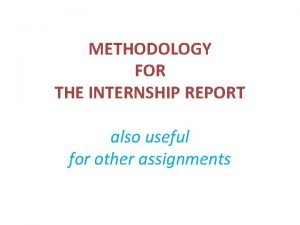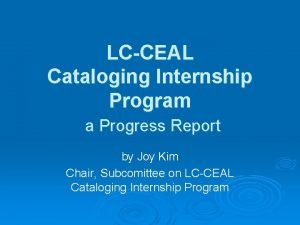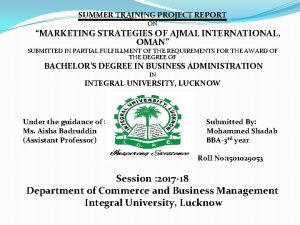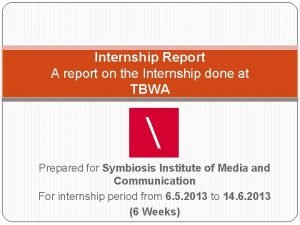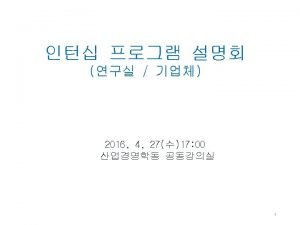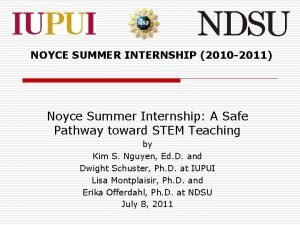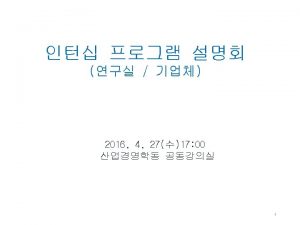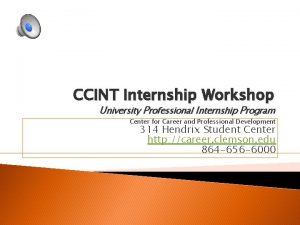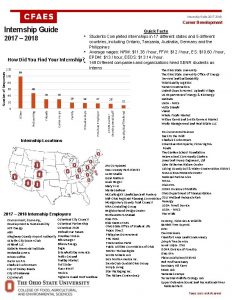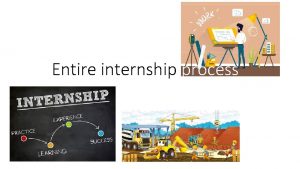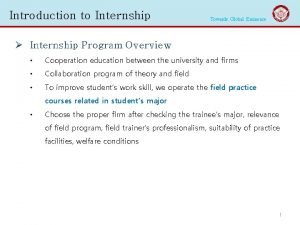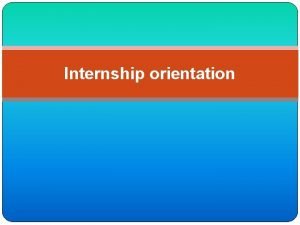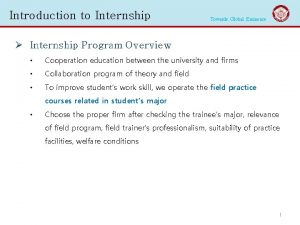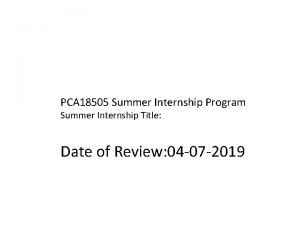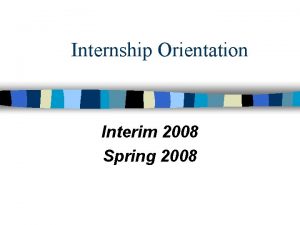METHODOLOGY FOR THE INTERNSHIP REPORT also useful for












































- Slides: 44

METHODOLOGY FOR THE INTERNSHIP REPORT also useful for other assignments

THE SUBJECT THE OUTLINE THE WRITING THE ORAL PRESENTATION

ANALYTICAL RELEVANT DYNAMIC REASONABLE THE SUBJECT INTERESTING MEANINGFUL HOMOGENEOUS CLEAR

THE SUBJECT Make it analytical FIND A FOCUS Interview The main issues in the sector A certain aspect of the person’s work Analysis Case study Audit of company’s strategies One aspect of working in France Importance or originality of the company in its sector A special project the person is working on A very specific theme related to the subject Experience Your initial project and the impact of this experience on your future professional choices Working methods you learned New issues you discovered

THE SUBJECT Make it reasonable DEFINE LIMITS • • Time period Geographical limits One specific aspect Case study Marketing in luxury cosmetics One specific aspect One or two brands One type of product Where When

THE SUBJECT Make it meaningful The reasons for the success of the French movie Amélie Poulain No question Only static information Was the French movie Amélie Poulain successful? Was the French component essential to the success of Amélie Poulain? Question with obvious answer Build an ARGUMENTATION around a QUESTION which implies NUANCES Question that gives meaning to information

THE SUBJECT Make it homogeneous STICK TO YOUR SUBJECT DON’T MIX angles themes concepts examples that are too different (unless the difference itself is the subject) Accept the frustration of OMITTING interesting aspects that are irrelevant (especially in the Interview and your Conclusions) Use THE INTRODUCTION to give information that doesn’t fit in your argumentation, but is necessary to understand your subject FINDING A MEANINGFUL TITLE IS THE ULTIMATE PROOF If you cannot find a real title, it often reflects a lack of coherence

THE SUBJECT Make it clear CLARIFY VAGUE WORDS “GOOD/BETTER” For what? For whom? What does “good” mean in this specific context? “EFFICIENT” To which goals does this word apply? What does it mean? A faster process? Lower costs? Measurable results? Is it a matter of quantity or of quality? “SUCCESS” Profits? Reputation? Development? Impact? Integrity? Sustainability?

THE SUBJECT Make it interesting TRY AND FIND AN ORIGINAL ANGLE GENERAL ISSUE RAISED BY SPECIFIC CASE STUDY CONTRADICTION WITH THE GENERAL OPINION PARADOXICAL IDEA CONFRONTATION OF THEORY AND REALITY PHILOSOPHY, ETHICS, VISION BEHIND THE FACTS

THE SUBJECT Make it dynamic DYNAMIC DEVELOPMENT • Ask a YES/NO question (introduction – no number) Is this endeavour sustainable? • Develop arguments 1. 2. 3. (different parts « 1 » « 2 » « 3 » ) The concept innovative => YES The technology needs improvement => YES, PROVIDED THAT. . . The financial aspects very costly => NO, UNLESS. . . • Answer the question (conclusion – no number) YES BECAUSE… BUT… NO BECAUSE…. UNLESS… 10

THE SUBJECT Make it relevant YOUR ORIGINAL SUBJECT MAY EVOLVE OR CHANGE Its relevance is tied to your research. PROCESS : 1. FIND A GENERAL THEME 2. DEFINE LIMITS 3. FORMULATE THE INITIAL QUESTION 4. DO RESEARCH 5. DEFINE ARGUMENTS 6. REFORMULATE YOUR SUBJECT

THE OUTLINE What is the point? What does it look like? The temptations The solutions The introduction The conclusion

THE OUTLINE What is the point? For YOU: it is a ROADMAP You don’t get lost while you write For YOUR PAPER: it is a SAFEGUARD No redundance, no off-limit ideas For YOUR READER: it is a GUIDE Your reader can follow you

THE OUTLINE What does it look like? INTRODUCTION I. PART 1 II. PART 2 III. PART 3 CONCLUSION No numbers for the Introduction and the Conclusion

THE OUTLINE What does it look like? INTRODUCTION • Why is the subject interesting? • What information do we need to know? • What is the question? What are themes? PART 1 • Introduction • Subpart 1 • Subpart 2 • Subpart 3 • Conclusion and transition PART 2 • Introduction • Subpart 1 • Subpart 2 • Subpart 3 • Conclusion & transition CONCLUSION PART 3 • Introduction • Subpart 1 • Subpart 2 • Subpart 3 • Conclusion & transition • Synthesis of the arguments • Final answer to the question and opening

THE OUTLINE What does it look like? 3 Parts: equivalent length Introduction with paragraphs Subpart titles 3 Parts: main titles (I. III. ) Conclusion with paragraphs

THE OUTLINE Temptation 1 The YES/NO outline: 1. Yes / Advantages / Thesis 2. No / Disadvantages / Antithesis

Result of a Yes/No Outline 1. ADVANTAGES v. Tasks are clearly distributed among employees, so everybody knows what he/she has to do. v. The general atmosphere is friendly, so the employees are motivated to come to work. REDUNDANT !!! 2. DISADVANTAGES v. Each employee’s tasks are very specific, so there is no general vision on a project. v. The employees, who are friends, often talk about personal things during work, which causes a waste of time.

THE OUTLINE Temptation 2 The Description/Evaluation outline: 1. Facts/Description 2. Comparison/Analysis/Evaluation

Result of a Description/Evaluation Outline 1. THE SITUATION v. The organization = facts v. The atmosphere = facts v. The budget = facts REDUNDANT !!! 2. THE ANALYSIS v. The organization = reminder of facts + analysis v. The atmosphere = reminder of facts + analysis v. The budget = reminder of facts + analysis

The solutions: identify THEMES 1. A VERY RIGOROUS ORGANIZATION v(Description) Tasks are clearly distributed among employees. v (Good) So everybody knows what he/she has to do. v (Bad) But there is no general vision on a project. v(Conclusion) Regular meetings could improve this aspect. 2. A FRIENDLY ATMOSPHERE v(Description) The atmosphere is very friendly ; employees often talk about personal things. v(Good) This motivates people to come to work. v(Bad) But unprofessional interactions often interfere with work requirements. v(Conclusion) This raises the question of productivity, because even if a lot of time is spent in coffee breaks, in the end all projects are completed.

The solutions: a PROGRESSIVE outline From the most ABSTRACT to the most CONCRETE (or conversely) I. Cultural aspects II. Political aspects III. Economical aspects From the most GENERAL to the most SPECIFIC (or conversely) I. The vision II. The style III. The subject From the most « NO » to the most « YES » (or conversely) I. A bad financial situation II. An evolving market III. A proactive dynamism

The solutions: build each part RATIONALLY a) General theory b) Observations c) Confrontation between theory and reality a) Example 1 (description) b) Example 2 (description) c) Comparison, evaluation, conclusion a) b) c) d) Observations / description Advantages Disadvantages General evaluation a) Observations b) Analysis c) Interpretation through general theory Eveything that does not fit in your parts goes in the introduction

The solutions: TRANSITIONS for fluidity 1. A VERY RIGOROUS ORGANIZATION v……… v(Conclusion) Regular meetings could improve this aspect. And this should not be difficult, given the general atmosphere in the office. 2. A FRIENDLY ATMOSPHERE v…… Each part begins with an INTRODUCTION, ends with a CONCLUSION of its own, and announces the next part.

THE INTRODUCTION Ø Introduces the main theme / context, Ø Gives the general information needed, Ø States the subject (raises the question), Ø Announces the outline (= French tradition), without giving any answer

THE CONCLUSION Ø Synthetizes the main ideas previouly developed, Ø Gives an answer to the question raised in the introduction, Ø May express a general judgment and suggest possible solutions/alternatives, Ø Ends with an opening. No « I »

THE WRITING Your reader should remain. . . RELAXED ØHis reading should be fluid. He shouldn’t lose track and have to go back and reread. ØHe should trust your reliability. He shouldn’t doubt about the truthfulness of ideas, facts, assertions PASSIVE ØHe shouldn’t have to rely on his memory and ask himself: « Who is this? » « What is this? » « Where is this? » ØHe shouldn’t have to read your mind ask himself: « Why? » « How? » « Yes, but what exactly? » ØHe shouldn’t have to think and ask himself: « Where is this going? » « So what does this prove? »

RELIABILITY It is not your opinion No « I » I think One could say/think It seems It is probable/likely Obviously

RELIABILITY But it is your work No outside correction on French No plagiarism As Mr Hyde, journalist for the No paraphrase THE SOLUTION • Quotation marks + reference • Personal comment on the implications or interest of the quotation London Tribune, explains: « If things were different, it would not be the same. » And indeed, this confirms the complexity of this issue.

RELIABILITY Prove or validate assertions This company is very dynamic. ? ? So… By examples By facts For instance, it participates in several fairs every year. It opened 5 new offices during the last 2 years. By quotations As Gérard Bouchard, the company sales manager, writes in his article Life of a salesman : “We need to always find new ways to promote our products. ” Don’t forget to also prove the validity of your sources

EXPLICIT INFORMATION Define terms Nicolas Sarkozy ? ? encouraged enforcement of the Hadopi Law ? ? . the Nicolas Sarkozy, the former French President, encouraged the enforcement of the Hadopi Law, a law aiming to suppress Internet piracy in France. OTHER SOLUTION Nicolas Sarkozy* encouraged the enforcement of the Hadopi Law*. *Nicolas Sarkozy : French President -2007 -2012 *Hadopi : law aiming to suppress Internet piracy in France

EXPLICIT LOGIC Detail all the steps of a reasoning After the depression, the company had to create a new campaign. WHY? ? ? After the depression, the products didn’t sell as well ; so the company had to create a new campaign. The colors chosen for this campaign are blue and white. AND SO? ? ? The colors chosen for this campaign are blue and white, which suggest an image of purity.

EXPLICIT IDEAS Don’t remain vague The company should improve its marketing strategies ? ? . I learned how ? ? ? a company functions. HOW? ? ? SO HOW DOES IT? ? ? The company should improve its marketing strategies, by developing a more active communication on the Internet, though Facebook and Twitter. I learned that a company functions thanks to several aspects: a clear distribution of tasks and an ongoing communication between employees.

COHERENCE The French logic • Whereas Americans start with the conclusion, demonstrate it, then confirm it First, bla. Then bla. Finally bla. From this we can conclude that this company is successful. This company is successful and here is why. Bla bla. So this company is successful. • French start with the reasoning, and end with the conclusion NEVER give the answer, judgment, final conclusion in the introduction or at the beginning of your argumentation.

COHERENCE Always refer to the initial question EACH PART SHOULD NATURALLY END WITH A CONCLUSION GIVING A PARTIAL ANSWER TO THE QUESTION STATED IN THE INTRODUCTION.

COHERENCE The last sentence is essential IT SHOULD NOT BE BANAL NEGATIVE Thank you for your patience. It was interesting and not boring. IT COULD BE A SYMPHONY FINALE And this philosophy could lead to a better world. A CLIFFHANGER Only the future will tell. . .

CLARITY AND FLUIDITY Writing in french Don’t translate literally English sentences: they often are too complex. Short and idiomatic terms are the most dangerous. Long and elaborate words usually match. Use short and simple structures with elaborate vocabulary Use specialized articles/websites to find specialized terms and phrases.

CLARITY AND FLUIDITY Quotations in French • Insert partial sentences into your text. • Separate visually long quotations (paragraphs) from your text. Quotations in English • Never translate from English into French. • Use only English quotations that make sense (full sentences). • Never mix English and French. Separate English quotations and put them in italics. • Summarize the main ideas in French before or after the quotation. Don’t let too long references ruin fluidity: use footnotes

CLARITY AND FLUIDITY The format Large titles Separate paragraphs Separate quotations Lists Bullet points Illustrations Footnotes

CLARITY AND FLUIDITY The format VISUAL TOOLS TO PRESENT FACTS Boxes for quotations or chronologies « Our main goal is to improve the educational system. » 35 30 25 20 15 10 5 0 ty ici pl m co s hs ug la kis se fli ct s complicity 29% co n 1990: 1994: 1995: 1996: 1998: laughs 22% conflicts 33% kisses 16% Foundation of the company 1 st campaign for its product Glout Merging with Zlub Creation of a new collection Award for the best financial disaster Graphs for statistics

THE ORAL PRESENTATION Written and oral approaches are different Your reader can take his time Your audience has time constraints You need to be selective about what you say Your reader is free to stop reading Your audience is stuck with you You need to keep your audience interested Your reader sees what is written The audience only relies on your speech You need to be articulate and use visuals (only if necessary)

THE ORAL PRESENTATION Defeat the enemies, conquer your audience Defeat JUDGEMENT by looking and acting PROFESSIONAL Defeat DEFIANCE by being and looking PREPARED Defeat INDIFFERENCE by being INTERACTIVE Defeat IMPATIENCE by respecting the FORMAT (no reading) (clean notes) (time limits, structure)

THE ORAL PRESENTATION Defeat the enemies, conquer your audience Defeat CLUELESSNESS by orally stressing the STRUCTURE (“First” “To conclude”) Defeat DROWSINESS by using HIGHLIGHTS (“This is due to 3 reasons: ” “What is important here is…”) Defeat CONFUSION by being CLEAR (voice, pronunciation) Defeat BOREDOM by stressing the UNEXPECTED (insist on the most original ideas)

THE ORAL PRESENTATION Powerpoint: to use with moderation! Powerpoint presentations only serve for landmarks and illustrations. Few words No mistakes Relevant images
 Methodology in internship report
Methodology in internship report Materials that can be useful and harmful
Materials that can be useful and harmful Ongc summer internship
Ongc summer internship Progress report for internship
Progress report for internship National bank internship report
National bank internship report Summer internship project report on marketing strategy
Summer internship project report on marketing strategy ưu thế lai là gì
ưu thế lai là gì Môn thể thao bắt đầu bằng chữ f
Môn thể thao bắt đầu bằng chữ f Tư thế ngồi viết
Tư thế ngồi viết Cái miệng xinh xinh thế chỉ nói điều hay thôi
Cái miệng xinh xinh thế chỉ nói điều hay thôi Hát kết hợp bộ gõ cơ thể
Hát kết hợp bộ gõ cơ thể Từ ngữ thể hiện lòng nhân hậu
Từ ngữ thể hiện lòng nhân hậu Mật thư tọa độ 5x5
Mật thư tọa độ 5x5 Tư thế ngồi viết
Tư thế ngồi viết Chó sói
Chó sói Thẻ vin
Thẻ vin Thế nào là giọng cùng tên
Thế nào là giọng cùng tên Thể thơ truyền thống
Thể thơ truyền thống Các châu lục và đại dương trên thế giới
Các châu lục và đại dương trên thế giới Hổ sinh sản vào mùa nào
Hổ sinh sản vào mùa nào Thế nào là hệ số cao nhất
Thế nào là hệ số cao nhất Diễn thế sinh thái là
Diễn thế sinh thái là Vẽ hình chiếu vuông góc của vật thể sau
Vẽ hình chiếu vuông góc của vật thể sau Thế nào là mạng điện lắp đặt kiểu nổi
Thế nào là mạng điện lắp đặt kiểu nổi Làm thế nào để 102-1=99
Làm thế nào để 102-1=99 Lời thề hippocrates
Lời thề hippocrates Thang điểm glasgow
Thang điểm glasgow đại từ thay thế
đại từ thay thế Quá trình desamine hóa có thể tạo ra
Quá trình desamine hóa có thể tạo ra Công thức tiính động năng
Công thức tiính động năng Sự nuôi và dạy con của hươu
Sự nuôi và dạy con của hươu Dạng đột biến một nhiễm là
Dạng đột biến một nhiễm là Biện pháp chống mỏi cơ
Biện pháp chống mỏi cơ Bổ thể
Bổ thể Vẽ hình chiếu đứng bằng cạnh của vật thể
Vẽ hình chiếu đứng bằng cạnh của vật thể độ dài liên kết
độ dài liên kết Thiếu nhi thế giới liên hoan
Thiếu nhi thế giới liên hoan Chúa yêu trần thế alleluia
Chúa yêu trần thế alleluia điện thế nghỉ
điện thế nghỉ Một số thể thơ truyền thống
Một số thể thơ truyền thống Trời xanh đây là của chúng ta thể thơ
Trời xanh đây là của chúng ta thể thơ Sơ đồ cơ thể người
Sơ đồ cơ thể người Bảng số nguyên tố lớn hơn 1000
Bảng số nguyên tố lớn hơn 1000 Fecboak
Fecboak
